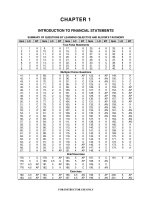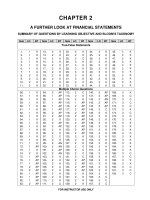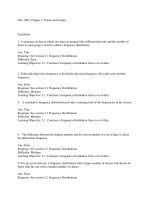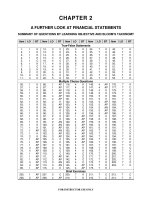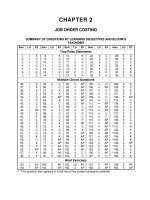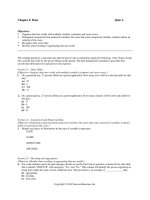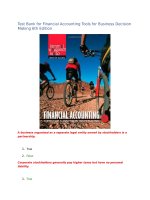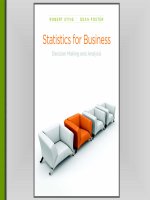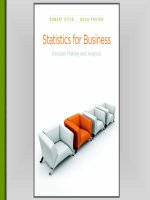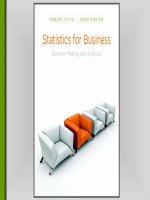Statistics for business decision making and analysis robert stine and foster chapter 01
Bạn đang xem bản rút gọn của tài liệu. Xem và tải ngay bản đầy đủ của tài liệu tại đây (1008.87 KB, 18 trang )
Chapter 1
Introduction
Copyright © 2011 Pearson Education, Inc.
1.1 What is Statistics?
Some Basic Ideas
Statistics as a discipline
Questions we can answer with statistics
Variation, patterns and models
3 of 18
Copyright © 2011 Pearson Education, Inc.
1.1 What is Statistics?
Statistics as a Discipline
Science and art of extracting answers from data
A statistic is a property of data
Statistics can be numbers (like an average) or
graphs that display information (like a timeplot)
4 of 18
Copyright © 2011 Pearson Education, Inc.
1.1 What is Statistics?
Typical Questions Statistics Help to Answer
Which customers are interested in an MP3
player?
How much are customers willing to pay for an
MP3 player?
Why does a shopper choose a particular box of
cereal?
5 of 18
Copyright © 2011 Pearson Education, Inc.
1.1 What is Statistics?
Variation, Patterns and Models
Variation refers to differences among items /
individuals or fluctuations over time
Patterns are systematic or predictable features in
data
Models break down variation into a pattern and
unexplained variation
6 of 18
Copyright © 2011 Pearson Education, Inc.
1.1 What is Statistics?
Statistical Models
Key to extracting answers from data
Good models simplify reality
Finding real patterns helps us to understand data,
plan for the future, and make better decisions
7 of 18
Copyright © 2011 Pearson Education, Inc.
1.2 Previews
Predicting Employment
8 of 18
Copyright © 2011 Pearson Education, Inc.
1.2 Previews
Predicting Employment
Back in September 2005, how could you forecast
employment in October?
Use monthly employment data for U.S. beginning
January 2003.
Prepare a timeplot (a chart of values ordered in
time) to display monthly employment data
9 of 18
Copyright © 2011 Pearson Education, Inc.
1.2 Previews
Timeplot of Employment Data
10 of 18
Copyright © 2011 Pearson Education, Inc.
1.2 Previews
Linear Pattern and Region of Uncertainty
11 of 18
Copyright © 2011 Pearson Education, Inc.
1.2 Previews
Conclusions
Extrapolating the pattern (line) into the future
provides a forecast for October
Actual employment for October is less than
expected and below the anticipated range
This surprising result breaks from the pattern and
deserves attention (the Katrina effect?)
12 of 18
Copyright © 2011 Pearson Education, Inc.
1.2 Previews
Pricing a Car
13 of 18
Copyright © 2011 Pearson Education, Inc.
1.2 Previews
Pricing a Car
Is $22,000 too much to spend on a 2002 BMW
325i with 53,000 miles?
Get prices for a sample of certified used BMW’s
from the Philadelphia area in November 2005
Prepare a scatterplot (a graph showing pairs of
values) of price versus mileage for this sample
14 of 18
Copyright © 2011 Pearson Education, Inc.
1.2 Previews
Scatterplot of Price Versus Mileage
15 of 18
Copyright © 2011 Pearson Education, Inc.
1.2 Previews
Line and Region of Uncertainty
16 of 18
Copyright © 2011 Pearson Education, Inc.
1.2 Previews
Conclusions
The range of uncertainty is so wide because
factors other than mileage affect price
This model uses all of the data to answer the
question about one used car (borrowing strength)
$22,000 isn’t too much to pay (it is less than
predicted by our line and within the range)
17 of 18
Copyright © 2011 Pearson Education, Inc.
1.3 How to Use This Book
The Four M’s
Motivation: reason for answering a question or
solving a problem
Method: plan for addressing the problem
Mechanics: performing the calculations,
generating graphs and displays
Message: explanation of conclusions
18 of 18
Copyright © 2011 Pearson Education, Inc.
